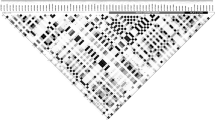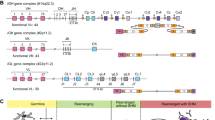Abstract
The HLA genomic structure underlines the permanence of fixed haplotypes transmitted in blocks as allelic combinations. One of the most discussed concerns is how and why such a strong linkage between HLA alleles has been maintained for so long. We hypothesized a possible KIR-driven pressure in the genesis of specific HLA-A,B haplotypes. Certain HLA-A and -B molecules are ligands for the same KIR receptors through the Bw4 binding motif spanning residues 77–83 in the α1 domain. We analyzed the HLA-A and -B genomic types of 9897 Caucasian people (3533 newborns and 6364 adults) subdividing them according to the presence/absence of the HLA-B Bw4 serological epitope. For each HLA-B Bw4- and Bw6-cross-reactive group, we evaluated the presence/absence of HLA-A ligands for KIR3DL1 (HLA-A*23, HLA-A*24, HLA-A*32) and KIR3DL2 (HLA-A*03, HLA-A*11). The frequency of HLA-A KIR ligands significantly increased moving from the HLA-B Bw4/Bw4 to the HLA-B Bw4/Bw6 and the HLA-B Bw6/Bw6 groups among both newborns and adults (P<0.0001). Here, we suggest that, when the HLA-B KIR-ligand motif is lacking, the HLA-A KIR-ligand might have a vicarious role in controlling the natural killer cell-mediated innate immune response. Basing upon this compensatory function in the engagement of KIR receptors, we hypothesize that specific HLA-A,B ancestral haplotypes were generated.
This is a preview of subscription content, access via your institution
Access options
Subscribe to this journal
Receive 6 digital issues and online access to articles
$119.00 per year
only $19.83 per issue
Buy this article
- Purchase on Springer Link
- Instant access to full article PDF
Prices may be subject to local taxes which are calculated during checkout



Similar content being viewed by others
References
Sharma D, Bastard K, Guethlein LA, Norman PJ, Yawata N, Yawata M et al. Dimorphic motifs in D0 and D1+D2 domains of killer cell Ig-like receptor 3DL1 combine to form receptors with high, moderate, and no avidity for the complex of a peptide derived from HIV and HLA-A*2402. J Immunol 2009; 183: 4569–4582.
Single RM, Martin MP, Gao X, Meyer D, Yeager M, Kidd JR et al. Global diversity and evidence for coevolution of KIR and HLA. Nat Genet 2007; 39: 1114–1119.
Gendzekhadze K, Norman PJ, Abi-Rached L, Graef T, Moesta AK, Layrisse Z et al. Co-evolution of KIR2DL3 with HLA-C in a human population retaining minimal essential diversity of KIR and HLA class I ligands. Proc Natl Acad Sci USA 2009; 106: 18692–18697.
Middleton D, Gonzelez F . The extensive polymorphism of KIR genes. Immunology 2010; 129: 8–19.
Campbell KS, Purdy AK . Structure/function of human killer cell immunoglobulin-like receptors: lessons from polymorphisms, evolution, crystal structures and mutations. Immunology 2011; 132: 315–325.
Sanchez-Mazas A, Fernandez-Viña M, Middleton D, Hollenbach JA, Buhler S, Di D et al. Immunogenetics as a tool in anthropological studies. Immunology 2011; 133: 143–164.
Hiby SE, Apps R, Sharkey AM, Farrell LE, Gardner L, Mulder A et al. Maternal activating KIRs protect against human reproductive failure mediated by fetal HLA-C2. J Clin Invest 2010; 120: 4102–4110.
Moretta A, Pende D, Locatelli F, Moretta L . Activating and inhibitory killer immunoglobulin-like receptors (KIR) in haploidentical haemopoietic stem cell transplantation to cure high-risk leukaemias. Clin Exp Immunol 2009; 157: 325–331.
Stern M, Ruggeri L, Capanni M, Mancusi A, Velardi A . Human leukocyte antigens A23, A24, and A32 but not A25 are ligands for KIR3DL1. Blood 2008; 112: 708–710.
Foley BA, De Santis D, Van Beelen E, Lathbury LJ, Christiansen FT, Witt CS . The reactivity of Bw4+ HLA-B and HLA-A alleles with KIR3DL1: implications for patient and donor suitability for haploidentical stem cell transplantations. Blood 2008; 112: 435–443.
Sivori S, Falco M, Carlomagno S, Romeo E, Soldani C, Bensussan A et al. A novel KIR-associated function: evidence that CpG DNA uptake and shuttling to early endosomes is mediated by KIR3DL2. Blood 2010; 116: 1637–1647.
Sivori S, Falco M, Moretta L, Moretta A . Extending killer Ig-like receptor function: from HLA class I recognition to sensors of microbial products. Trends Immunol 2010; 31: 289–294.
Capittini C, Pasi A, Bergamaschi P, Tinelli C, De Silvestri A, Mercati MP et al. HLA haplotypes and birth weight variation: is your future going to be light or heavy? Tissue Antigens 2009; 74: 156–163.
Dawkins RL, Christiansen FT, Kay PH, Garlepp M, McCluskey J, Hollingsworth PN et al. Disease associations with complotypes, supratypes and haplotypes. Immunol Rev 1983; 70: 5–22.
Steele EJ, Williamson JF, Lester S, Stewart BJ, Millman JA, Carnegie P et al. Genesis of ancestral haplotypes: RNA modifications and reverse transcription-mediated polymorphisms. Hum Immunol 2011; 72: 283–293.
Contu L, Carcassi C, Dausset J . The ‘Sardinian’ HLA-A30,B18,DR3,DQw2 haplotype constantly lacks the 21-OHA and C4B genes Is it an ancestral haplotype without duplication? Immunogenetics 1989; 30: 13–17.
Cagliani R, Riva S, Pozzoli U, Fumagalli M, Comi GP, Bresolin N et al. Balancing selection is common in the extended MHC region but most alleles with opposite risk profile for autoimmune diseases are neutrally evolving. BMC Evol Biol 2011; 11: 171.
Hill AV, Elvin J, Willis AC, Aidoo M, Allsopp CE, Gotch FM et al. Molecular analysis of the association of HLA-B53 and resistance to severe malaria. Nature 1992; 360: 434–439.
Piazza A, Olivetti E, Griffo RM, Rendine S, Amoroso A, Barbanti M et al. The distribution of HLA antigens in Italy. Gene Geogr 1989; 3: 141–164.
Martinetti M, Degioanni A, D'Aronzo AM, Benazzi E, Carpanelli R, Castellani L et al. An immunogenetic map of Lombardy (Northern Italy). Ann Hum Genet 2002; 66: 37–48.
Price P, Witt C, Allcock R, Sayer D, Garlepp M, Kok CC et al. The genetic basis for the association of the 8.1 ancestral haplotype (A1, B8, DR3) with multiple immunopathological diseases. Immunol Rev 1999; 167: 257–274.
Bansal A, Yue L, Conway J, Yusim K, Tang J, Kappes J et al. Immunological control of chronic HIV-1 infection: HLA-mediated immune function and viral evolution in adolescents. AIDS 2007; 21: 2387–2397.
Dinges WL, Richardt J, Friedrich D, Jalbert E, Liu Y, Stevens CE et al. Virus-specific CD8+ T-cell responses better define HIV disease progression than HLA genotype. J Virol 2010; 84: 4461–4468.
Guethlein LA, Older Aguilar AM, Abi-Rached L, Parham P . Evolution of killer cell Ig-like receptor (KIR) genes: definition of an orangutan KIR haplotype reveals expansion of lineage III KIR associated with the emergence of MHC-C. J Immunol 2007; 179: 491–504.
Olerup O, Zetterquist H . HLA-DR typing by PCR amplification with sequence-specific primers (PCR-SSP) in 2 h: an alternative to serological DR typing in clinical practice including donor-recipient matching in cadaveric transplantation. Tissue Antigens 1992; 39: 225–235.
De Vreese K, Barylski R, Pughe F, Bläser M, Evans C, Norton J et al. Performance characteristics of updated INNO-LiPA assays for molecular typing of human leukocyte antigen A (HLA-A), HLA-B, and HLA-DQB1 alleles. Clin Diagn Lab Immunol 2004; 11: 430–432.
Acknowledgements
This work was financially supported by current research projects numbers 556 (starting from 2009 and ending in 2012) and 657 (starting from 2011 and ending in 2014) of the IRCCS Foundation Policlinico San Matteo (Pavia). The present study was honored with two awards given by the Associazione Donatori Midollo Osseo (ADMO, Italy) in 2007 and 2010. We are deeply in debt to the 9897 generous people who expressed their willingness to donate and to participate in this research program. We wish to thank the two anonymous reviewers for their constructive observations on the draft of this manuscript.
Author information
Authors and Affiliations
Corresponding author
Ethics declarations
Competing interests
The authors declare no conflict of interest.
Rights and permissions
About this article
Cite this article
Capittini, C., Tinelli, C., Guarene, M. et al. Possible KIR-driven genetic pressure on the genesis and maintenance of specific HLA-A,B haplotypes as functional genetic blocks. Genes Immun 13, 452–457 (2012). https://doi.org/10.1038/gene.2012.14
Received:
Revised:
Accepted:
Published:
Issue Date:
DOI: https://doi.org/10.1038/gene.2012.14
Keywords
This article is cited by
-
KIR and HLA under pressure: evidences of coevolution across worldwide populations
Human Genetics (2015)



